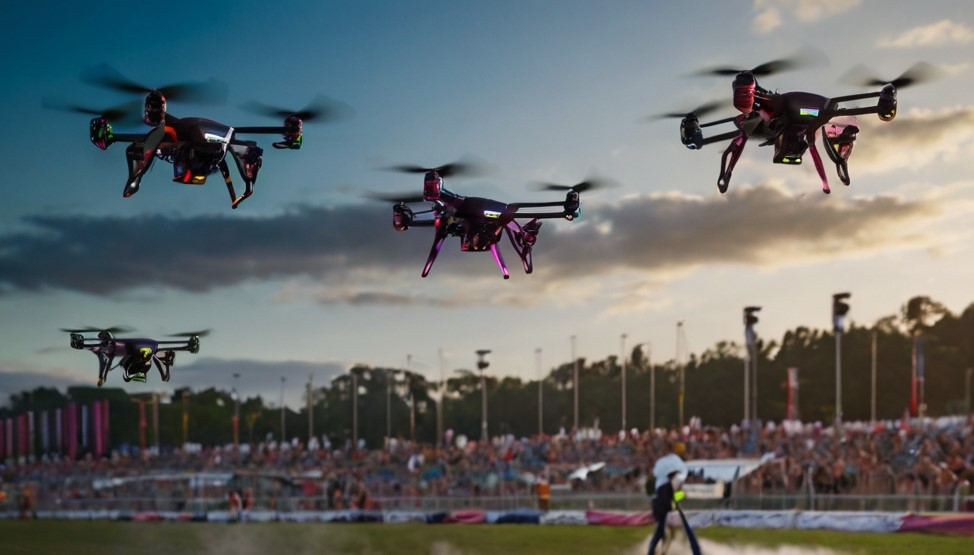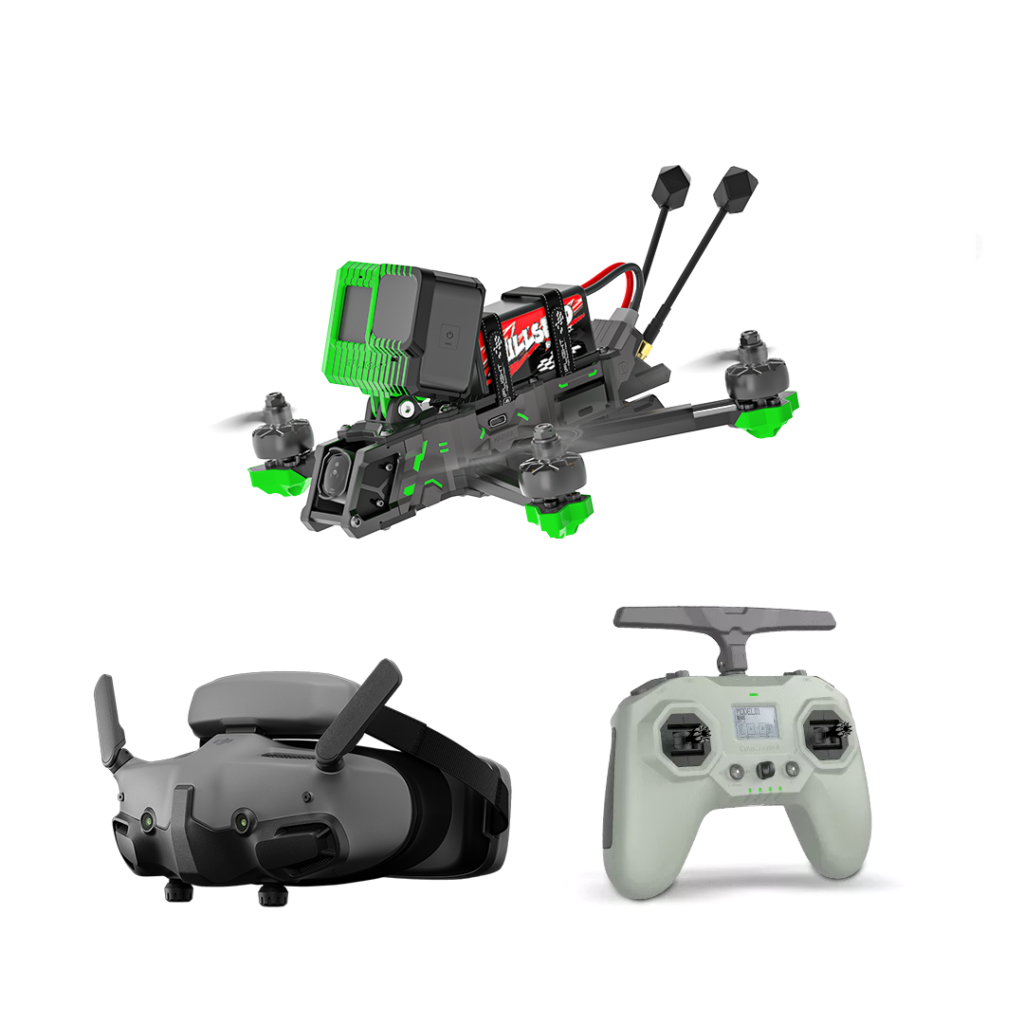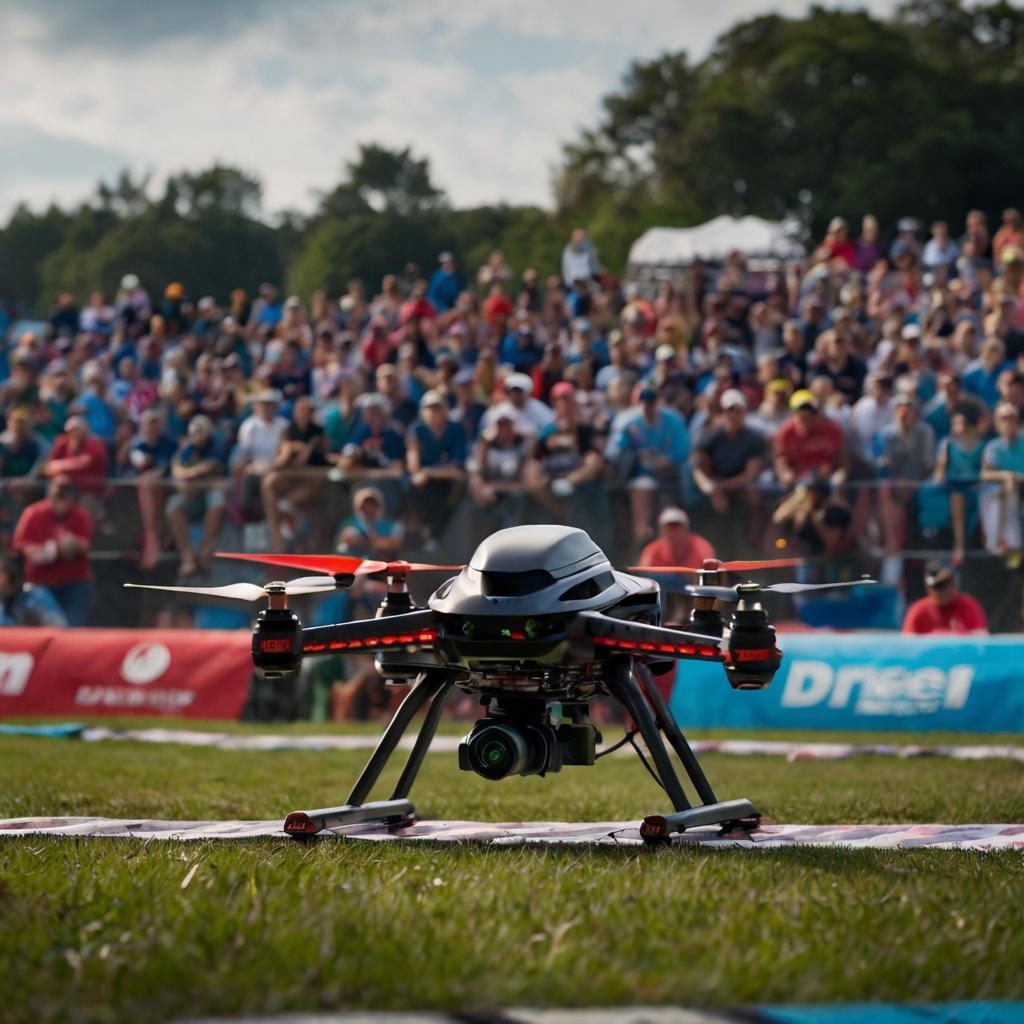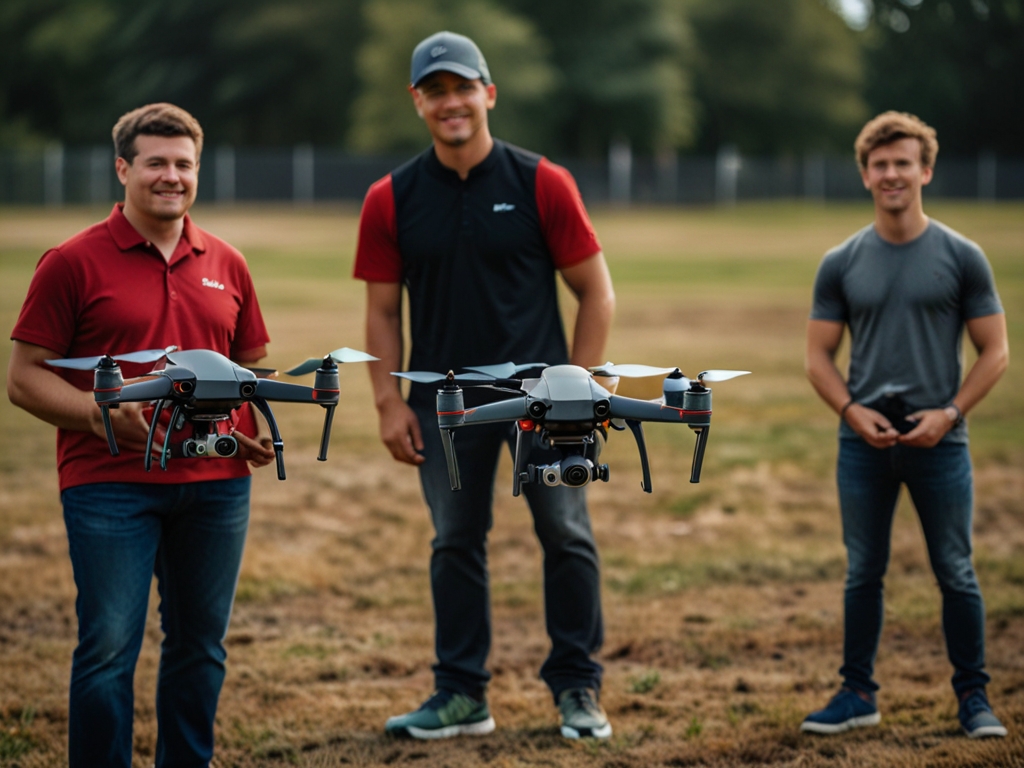Drone Racing – The Adrenaline-Fueled Future of Racing
Hey there! Some links on this page are affiliate links which means that, if you choose to make a purchase, I may earn a small commission at no extra cost to you. I greatly appreciate your support! Please see our Disclosure to learn more.
Introduction
Hello there, FPV racing enthusiasts and curious adventurers! My name is Jeff Corbyn. Welcome to the thrilling world of drone racing, where the excitement of high-speed racing meets the cutting-edge technology of unmanned aerial vehicles (UAVs). If you’re new to this adrenaline-fueled sport, buckle up and get ready for an exhilarating ride. In this article, we’ll be diving headfirst into the heart of drone racing, exploring what makes it such a captivating and rapidly growing phenomenon. So, whether you’re a seasoned pilot looking to stay up-to-date or a newcomer eager to learn more, sit back, relax, and let’s embark on this high-flying journey together!
What is Drone Racing?
Drone racing is an exhilarating, high-octane sport that merges the adrenaline rush of high-speed competition with the innovative technology of unmanned aerial vehicles (UAVs), commonly known as drones. This rapidly growing sport pushes the boundaries of both piloting skill and technological advancement, creating a unique and thrilling experience for pilots and spectators alike. At its core, drone racing involves pilots remotely controlling small, powerful drones as they navigate through complex, obstacle-filled courses at incredible speeds.
Imagine strapping on a pair of specialized FPV (First-Person View) goggles and being instantly transported into the cockpit of your drone, seeing exactly what it sees as it hurtles through the air. The sensation is as close to flying as one can get without leaving the ground, as you weave through tight turns, accelerate down straightaways, and execute precise maneuvers to outpace your competitors. These drones are not just toys; they are sophisticated machines, equipped with advanced motors, cameras, and communication systems, all designed to deliver peak performance during a race.
Drone racing has quickly evolved from a niche hobby into a competitive sport with organized leagues, global tournaments, and a dedicated community of enthusiasts. The sport’s unique combination of speed, technology, and strategy offers a fresh, futuristic take on motorsports, capturing the imagination of people around the world. Whether you’re a pilot chasing the perfect line or a spectator marveling at the agility and speed of these tiny aircraft, drone racing delivers an unparalleled thrill that keeps everyone coming back for more.
The Thrill and Excitement of Drone Racing

FPV racing offers an unparalleled adrenaline rush for pilots and spectators alike. As pilots navigate their drones through intricate courses at breakneck speeds, they must employ precision maneuvering and lightning-fast reflexes to stay competitive. The immersive first-person view (FPV) provided by onboard cameras and specialized goggles creates a unique sense of excitement, as if the pilot is sitting right in the cockpit of their tiny, powerful machine. This combination of cutting-edge technology, skill, and speed creates an exhilarating experience that keeps participants and fans coming back for more.
The Rise of Drone Racing

Drone racing is rapidly gaining popularity worldwide, attracting thrill-seekers, tech enthusiasts, and racing aficionados alike. What was once a niche hobby is now evolving into a mainstream sport, with professional leagues, sponsorships, and a dedicated global community.
The Evolution of Drone Racing
From Hobby to Sport
The origins of FPV drone racing can be traced back to the early enthusiasts of remote-controlled aircraft, who were always looking to push the limits of speed, control, and agility. In the early days, these hobbyists experimented with various modifications to enhance performance, often building custom setups to achieve faster speeds and more precise maneuvers. As technology advanced, significant improvements in the miniaturization of electronics, the development of lightweight frames, and the introduction of more powerful, high-efficiency motors revolutionized the field. These innovations paved the way for the emergence of high-performance racing drones, capable of breathtaking speeds and remarkable agility, transforming what was once a niche hobby into an exhilarating and competitive sport.
The Birth of FPV (First-Person View)
The development of FPV (First-Person View) technology marked a significant turning point in the world of drone racing, revolutionizing the way pilots interacted with their drones. This breakthrough allowed pilots to experience the thrill of flight as if they were actually inside the drone, offering an entirely new level of immersion and control. By donning specialized goggles that projected a live video feed directly from the drone’s onboard camera, pilots were able to navigate complex courses with unparalleled precision and confidence. This immersive experience not only enhanced the excitement of drone racing but also brought a new dimension of skill and strategy to the sport, making FPV technology a true game-changer in the evolution of competitive drone racing.
Early Competitions and Pioneers
While informal drone racing events had been taking place for years, the sport gained significant traction in the early 2010s with the rise of organized competitions and leagues. Pioneers like the Drone Racing League (DRL) and MultiGP helped establish rules, formats, and a global community of enthusiasts.
The Basics of Drone Racing
FPV Racing Drones
Components and Setup
At the heart of drone racing lies the specialized racing quadcopter, a finely tuned machine designed for speed, agility, and maneuverability. These drones typically feature powerful brushless motors, lightweight carbon fiber frames, and advanced flight controllers. Customizing and fine-tuning these components is crucial for optimal performance.
Popular Models and Brands
While many pilots prefer to build their own custom drones, there are also several popular off-the-shelf models and brands that cater to the FPV racing community. These ready-to-fly options offer a convenient way for both beginners and seasoned pilots to dive into the sport without the complexities of a custom build. Here are some notable examples:
EMAX Tinyhawk III Plus
The Tinyhawk III Plus is a lightweight and compact drone, perfect for indoor racing and tight spaces. It’s designed for beginners and experienced pilots, offering responsive controls and smooth flight performance. With its durable build and reliable FPV system, the Tinyhawk III Plus delivers a fun and immersive flying experience, making it a popular choice for those who enjoy fast-paced indoor racing.
BetaFPV Cetus X
The BetaFPV Cetus X is an ideal drone for beginners, designed with easy-to-use controls and stable flight characteristics. It features a lightweight frame and durable construction, perfect for those learning to fly. The Cetus X offers a smooth and steady flight, making it a great choice for new pilots looking to gain confidence in FPV racing.
Mr Steele ApexLR EVO 7″
The Mr Steele ApexLR EVO 7″ is a long-range drone built for durability and precision, perfect for advanced pilots. It features a robust frame and high-quality components, designed to withstand extended flights and challenging conditions. This drone is ideal for those seeking a reliable, high-performance option for long-distance FPV adventures.
The iFlight Nazgul Evoque

The iFlight Nazgul Evoque is a top-performing racing drone known for its speed, agility, and durability. It’s designed for competitive racing, with a strong frame and powerful motors that deliver excellent acceleration and maneuverability. This drone is a favorite among experienced pilots looking for a reliable, high-performance option on the racecourse.
FPV Goggles
To fully experience the thrill of drone racing, pilots rely on high-quality FPV goggles. These specialized goggles receive a real-time video feed from the drone’s onboard camera, allowing pilots to see and navigate the course from the drone’s perspective. Here are some popular options:
FatShark

FatShark is one of the most well-known brands in the FPV community, offering a range of high-quality goggles that are trusted by both amateur and professional pilots. Their goggles are known for their excellent image quality, comfortable fit, and reliable performance. FatShark models often feature adjustable diopters and modular designs, making them a versatile choice for many pilots.
DJI FPV goggles
DJI has revolutionized the FPV goggle market with their high-definition digital systems. Their user-friendly interface and high-quality build make them a top choice for those serious about FPV. DJI FPV goggles offer superior video clarity, low latency, and a seamless connection to DJI’s digital FPV systems. These goggles are ideal for pilots looking for the best possible visual experience, especially in high-speed racing or freestyle flying.
Skyzone goggles

Skyzone is another respected brand in the FPV goggle market, known for delivering high-quality products at competitive prices. Their goggles are appreciated for their vibrant displays, wide field of view, and integrated features such as head tracking and built-in receivers. Skyzone goggles are a great option for pilots who want a reliable and feature-rich experience without compromising on quality.
These FPV goggles are essential tools for pilots, providing the immersive first-person view that makes drone racing such an exhilarating experience.
Racing Formats and Rules
FPV racing competitions come in a variety of formats, each offering unique challenges and excitement for both pilots and spectators. These formats can range from time trials, where pilots compete to achieve the fastest lap times, to intense head-to-head races, where multiple drones fly simultaneously, battling for the top position. The diversity in race formats allows for a wide range of competitive experiences, catering to different skill levels and preferences.
To ensure fair and safe competition, rules and regulations are meticulously established and enforced by governing bodies like the Drone Racing League (DRL) and MultiGP. These organizations play a crucial role in standardizing the sport, providing a consistent framework that maintains the integrity of each race. The rules set by these governing bodies cover various aspects, including drone specifications, which dictate the size, weight, and power of the drones used in competition.
In addition to regulating the drones themselves, these organizations also establish guidelines for course design, ensuring that each race presents a balanced challenge that tests the pilots’ skills while maintaining safety. Stringent safety protocols are enforced to protect both the pilots and the audience, minimizing risks during high-speed races. By upholding these standards, the DRL, MultiGP, and other governing bodies help create a professional and thrilling environment for the growing community of FPV racing enthusiasts.
The Drone Racing Experience
The Pilot’s Perspective
As an FPV racing pilot, the experience is truly unmatched. Imagine the moment you strap on your FPV goggles, instantly transporting yourself into the heart of the action. You’re no longer just a spectator; you’re fully immersed in the high-speed, first-person view of the race. Every twist and turn of the course feels real as if you are actually inside the drone, racing through the air. Your reflexes are constantly tested to their limits as you navigate tight, challenging turns, weaving skillfully through obstacles that seem to appear out of nowhere. Maintaining precise control of the drone becomes critical, especially when flying at breakneck speeds that demand split-second decisions. The adrenaline rush is palpable, making each race an exhilarating and unforgettable experience.
The Spectator’s Thrill

While the pilot is immersed in a first-person view, spectators enjoy an equally thrilling experience from the ground. They get to witness the raw power and incredible agility of these drones as they race through the air. The sight of tiny machines zipping along at high speeds, executing sharp hairpin turns, and pulling off gravity-defying maneuvers is nothing short of spectacular. Each movement of the drones captivates the audience, leaving onlookers in awe of the skill and precision required to control these high-performance machines. The excitement builds with every lap, as spectators cheer on their favorite pilots, fully engaged in the intense competition unfolding before them.
The Adrenaline Rush of Drone Racing
Whether you’re a pilot or a spectator, FPV racing delivers an adrenaline rush that’s hard to match. For the pilots, the combination of speed, precision, and the immersive first-person view creates an electrifying experience that demands sharp reflexes and quick thinking. Spectators, on the other hand, feel the excitement as they watch drones tear through the course at breakneck speeds, each maneuver executed with pinpoint accuracy. The blend of cutting-edge technology and high-speed action makes drone racing a unique thrill that consistently draws enthusiasts back for more. The energy and excitement are contagious, making every race a heart-pounding experience for everyone involved.
The Drone Racing Community
Local Clubs and Groups

One of the most remarkable aspects of drone racing is the vibrant and welcoming community that surrounds it. Local clubs and groups offer opportunities for pilots to connect, share knowledge, and organize events and meetups.
Online Forums and Resources
The internet has played a crucial role in fostering the FPV racing community. Online forums, social media groups, and dedicated websites serve as valuable resources for pilots to discuss techniques, share builds, and stay up-to-date with the latest industry news and developments.
Meetups and Events
Regular meetups and events, both local and international, provide opportunities for pilots to compete, socialize, and celebrate their shared passion for drone racing. These events often feature exhibitions, workshops, and opportunities to meet industry leaders and influencers.
Getting Started in Drone Racing
Beginner’s Guide
If you’re new to FPV racing, fear not! The community is incredibly welcoming to newcomers, and there are numerous resources available to help you get started. From beginner’s guides to online tutorials, you’ll find a wealth of information to guide you through the initial steps.
Simulators and Practice
Before taking to the skies, it’s highly recommended to practice on simulators. These software programs allow you to hone your flying skills and familiarize yourself with the intricacies of drone racing in a safe, virtual environment.
Safety and Regulations
As with any activity involving high-speed machines, safety is paramount in FPV racing. Familiarize yourself with local regulations and guidelines, and always prioritize the safety of yourself, spectators, and the surrounding environment.
The Future of Drone Racing
Professional Leagues and Competitions
The FPV racing scene is rapidly evolving, with professional leagues and competitions gaining mainstream recognition. Organizations like the Drone Racing League (DRL) and MultiGP are leading the charge, offering lucrative prize pools and broadcasting events to audiences worldwide.
Technological Advancements
As technology continues to advance, the capabilities of racing drones will only improve. Innovations in battery life, motor efficiency, and aerodynamics could usher in a new era of even faster and more maneuverable drones, pushing the limits of what’s possible in drone racing.
Mainstream Adoption and Growth
With its growing popularity and accessibility, FPV racing is poised to become a mainstream sport in the coming years. As more people are exposed to the thrill and excitement of this cutting-edge activity, the community is likely to continue expanding, attracting new enthusiasts and further cementing its place in the world of motorsports.
Conclusion
Summary of Key Points
Drone racing is a thrilling and rapidly evolving sport that combines the adrenaline of high-speed competition with the cutting-edge technology of unmanned aerial vehicles. From its humble beginnings as a niche hobby to its current status as a global phenomenon, FPV racing has captivated enthusiasts and spectators alike with its immersive first-person experience, precision maneuvering, and vibrant community.
The Exciting Potential of Drone Racing
As the sport continues to grow and evolve, the future of FPV racing holds boundless potential. With advancements in technology, the rise of professional leagues and competitions, and an ever-expanding global community, drone racing is poised to become a mainstream sensation, captivating audiences and inspiring a new generation of thrill-seekers and tech enthusiasts.
FAQs
- How fast can racing drones go?
Racing drones can reach incredible speeds, with some models capable of hitting over 100 mph (160 km/h) in optimal conditions. - Is drone racing dangerous?
While FPV racing involves high speeds and precision maneuvering, safety is a top priority. Proper precautions, such as following regulations and maintaining a safe distance from spectators, help minimize risks. - How much does it cost to get into drone racing?
Entry-level racing drones can cost anywhere from a few hundred dollars to over a thousand dollars, depending on the quality and components. However, many enthusiasts start with simulators and gradually build their setups over time. - Can anyone participate in drone racing competitions?
Absolutely! FPV racing competitions often have categories for different skill levels, from beginner to professional. Many events welcome newcomers and offer opportunities to learn and grow within the community. - What skills are necessary for successful drone racing?
Successful FPV racing requires a combination of hand-eye coordination, quick reflexes, spatial awareness, and the ability to multitask and make split-second decisions. Practice and dedication are key to developing these skills.
Final Thoughts
As you embark on your FPV racing journey, remember that the most important thing is to have fun and enjoy the process of learning and growing. Don’t be discouraged by crashes or setbacks – they’re a natural part of the experience and provide valuable opportunities to learn and improve. Embrace the community, seek out mentors and fellow enthusiasts, and never stop pushing yourself to try new things. With dedication, practice, and a passion for the sport, you’ll soon find yourself soaring through the air with confidence and precision.
The world of drone racing is full of exciting challenges and thrilling rewards. By taking the first steps, you’ve already begun an adventure that will test your skills, ignite your imagination, and connect you with a vibrant global community of like-minded individuals. So, gear up, charge your batteries, and get ready to experience the adrenaline rush of a lifetime. Welcome to the exhilarating world of FPV racing – we can’t wait to see you on the course!









